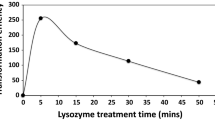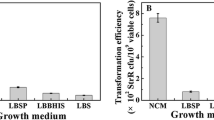Abstract
Plasmid-free acetogen Clostridium sp. MT962 electrotransformed with a small cryptic plasmid pMT351 was used to develop time- and cost-effective methods for plasmid elimination. Elimination of pMT351 restored production of acetate and ethanol to the levels of the plasmid-free strain with no dry cell weight changes. Destabilizing cell membrane via microwave at 2.45 GHz, or exposure to a single 12 ms square electric pulse at 35 kV cm−1, eliminated pMT351 in 42–47 % of cells. Plasmid elimination with a single square electric pulse required 10 versus 0.1 J needed to introduce the same 3,202-bp plasmid into the cells as calculated per cell sample of Clostridium sp. MT962. Microwave caused visible changes in repPCR pattern and increased ethanol production at the expense of acetate. This is the first report on microwave of microwave ovens, wireless routers, and mobile devices causing chromosomal DNA aberrations in microbes along with carbon flux change.



Similar content being viewed by others
References
Asseldonk M, deVos WM, Simons G (1993) Functional analysis of the Lactococcus lactis usp45 secretion signal in the secretion of a homologous proteinase and a heterologous α-amylase. MGG 240(3):428–434. doi:10.1007/BF00280397
Berzin V, Tyurin M (2012) Acetogen biocatalyst Clostridium sp. MTEtOH871 engineered with our proprietary electrotransformation technology and equipment: continuous synthesis gas fermentation for selective ethanol production. J Biotech Res 4:54–64
Berzin V, Kiriukhin M, Tyurin M (2012a) Elimination of acetate production to improve ethanol yield during continuous synthesis gas fermentation by engineered biocatalyst Clostridium sp. MTEtOH550. Appl Biochem Biotechnol 167:338–347. doi:10.1007/s12010-012-9697-5
Berzin V, Kiriukhin M, Tyurin M (2012b) Selective production of acetone during continuous synthesis gas fermentation by engineered biocatalyst Clostridium sp MAceT113. Lett Appl Microbiol doi:10.1111/j.1472-765X.2012.03272.x
Cook AR (1976) The elimination of urease activity in Streptococcus faecium as evidence for plasmid-coded urease. J Gen Microbiol 92(1):49–58
Demain AL (2009) Biosolutions to the energy problem. J Ind Microbiol Biotechnol 36(3):319–332
Fischer CR, Klein-Marcuschamer D, Stephanopoulos G (2008) Selection and optimization of microbial hosts for biofuels production. Metabol Eng 10(6):295–304
Hardy K (1986) Bacterial plasmids, 2nd ed. Springer, 142 pp
Hernández-Arriaga AM, Espinosa M, del Solar G (2012) Fitness of the pMV158 replicon in Streptococcus pneumoniae. Plasmid 67(2):162–166
Köpke M, Michalcea C, Liew F-M, Tizard JH, Ali MS, Conolly JJ, Al-Sinawi B, Simpson SD (2011) 2, 3-Butanediol production by acetogenic bacteria, an alternative route to chemical synthesis, using industrial waste gas. Appl Environ Microbiol 77(15):5467–5475
Ow DS-W, Lee D-Y, Yap MG-S, Oh SK-W (2009) Identification of cellular objective for elucidating the physiological state of plasmid-bearing Escherichia coli using genome-scale in silico analysis. Biotechnol Prog 25(1):61–67. doi:10.1021/bp.51
Ross SM (2000) Introduction to probability and statistics for engineers and scientists, 2nd edn. Academic Press, Inc., San Diego
Shamis Y, Taube A, Natasa M-D, Croft R, Crawford RJ, Ivanova EP (2011) Specific electromagnetic effects of microwave radiation on Escherichia coli. Appl Environ Microbiol 77(9):3017–3023
Tanner RS, Miller LM, Yang D (1993) Clostridium ljungdahlii sp. nov., an acetogenic species in clostridial rRNA homology group I. Int J Syst Bacteriol 43(2):232–236
Tiurin MV (1990) Optimization of the method of isolation of microamounts of plasmid DNA from lactobacilli. Mol Gen Mikrobiol Virusol 3:29–31
Tiurin MV, Shenderov BA, Panasenko VI (1989) Genetics of antibiotic resistance in lactobacilli. Antibiot Khimioter 34(7):539–544
Tiurin MV, Voroshilova EB, Rostova IuG, Oparina NIu, Gusiatiner MM (1998) Electric response of internal membrane structures of corynebacteria during electrotransformation. Mikrobiologiia 67(3):338–344
Trevors JT (1986) Plasmid curing in bacteria. FEMS Microbiol Lett 32(3–4):149–157
Tyurin (1990) Antibiotic resistance and antagonistic activity of lactobacilli. PhD-Thesis. USSR Research Institute for Antibiotics. Moscow, USSR
Tyurin MV (1992) The method and apparatus for electric cell treatment using partial capacitor discharge via the sample and the power tetrode. Russian Patent 2-005776
Tyurin MV, Livshits VA (1996) Electrotransformation of untreated streptomyces cells. Membrane and Cell Biology 10(3):303–309
Tyurin MV, Sullivan CR, Lynd LR (2005) Induced oscillations play an important role in high efficiency transformation of thermophilic anaerobes. Appl Environ Microbiol 71:8069–8076
Tyurin M, Kiryukhin M, Berzin V (2012) Electrofusion of untreated cells of the newly isolated acetogen Clostridium sp. MT351 with integrated in the chromosome erm(B) or cat leading to the combined presence of these antibiotic resistance genes in the chromosome of the electrofusion products. J Biotech Res 4:1–12
Acknowledgments
The research was supported solely by the funds of Syngas Biofuels Energy, Inc. Syngas Biofuels Energy, Inc., is the distributor of the electroporation and electrofusion equipment described in this report: www.syngasbiofuelsenergy.com.
Conflict of interest
The authors declare that they do not have any conflict of interest.
Author information
Authors and Affiliations
Corresponding author
Additional information
Communicated by Djamel Drider.
Rights and permissions
About this article
Cite this article
Berzin, V., Kiriukhin, M. & Tyurin, M. “Curing” of plasmid DNA in acetogen using microwave or applying an electric pulse improves cell growth and metabolite production as compared to the plasmid-harboring strain. Arch Microbiol 195, 181–188 (2013). https://doi.org/10.1007/s00203-012-0862-6
Received:
Revised:
Accepted:
Published:
Issue Date:
DOI: https://doi.org/10.1007/s00203-012-0862-6




